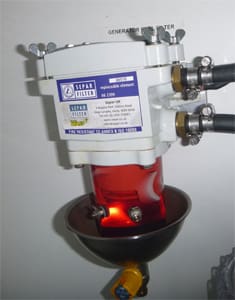As most of us know, good clean fuel is important to any diesel engine. Because of this, it is important to do proper routine maintenance to the fuel system to keep your engine performing well. A few simple inspections will help keep the fuel flowing and prevent engine failures or performance issues.
Keeping water and dirt from ever getting into the fuel tank and fuel system is the first step to maintaining a healthy setup. Checking the fuel source is not always easy to do, but there are some precautions that can be taken to help ensure clean fuel goes into the tank. Getting fuel from a reliable source is important. Try to fuel from marinas or other sources that have a high turnover in their fuel supply. Avoid fueling from a storage tank with old fuel or one that is close to empty. If possible, put a small sample into a clear container for visual inspection.
Next, make sure water cannot get into the vessel’s tank from outside sources. Water can enter through the fill plate on deck, the tank vent and even from the air in the tank. It is good practice to inspect the fill plate and cap every time fuel is put aboard. Take a few seconds to inspect the cap and seal for damage or wear. If anything does not look right, it should be fixed.
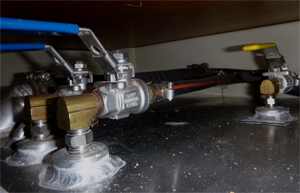 |
|
Inspecting the fuel system starts at the tank fittings. |
Often ignored, tank vents and fittings can cause problems by either letting water into the tank or preventing air from entering the tank. Make sure the vent hose has a loop above the tank top to trap any water entering the vent and prevent it from reaching the tank. The vent itself should be located high and in a place that will not allow seawater or rain water to enter.
Dealing with air
Tank vents have to allow air out of a tank when fueling in addition to letting air into the tank as fuel is withdrawn during engine operation. While fueling, if the fuel flow is slow or air “burps” from the fill, there may be a problem with the vent and fittings. I have seen tanks collapse during use when a clogged vent would not allow air into the tank when running the engine. I have also seen many engines mysteriously lose rpm and run poorly because the fuel supply was restricted by a vacuum in the tank. Insect nests, wood chips or debris from rubbing on a dock can completely block air from entering the tank. Routine inspections of the vent, fittings, hoses and any anti-spill devices will help prevent these issues.
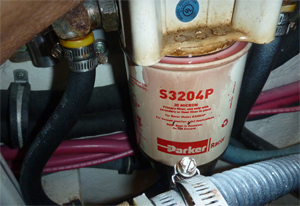 |
|
A leaking fuel filter that needs immediate replacement. |
Although air is needed in a fuel tank, it can be a double-edged sword since it brings moisture in with it. This moisture can condensate on the insides of the tank during temperature changes. Keeping the tanks full of fuel, particularly during periods of layup, will go a long way in reducing this problem.
If the filters are often clogged or dirty, it may indicate possible contamination in the tanks — fuel polishing may be in order. “Polishing” is filtering the fuel by cycling it through large filters. This is usually done by placing a pickup tube into the tank as close to the bottom as possible, then using a high-volume pump to run the fuel through the large filters and then back into the tank. The fuel is cycled through the filters until it is clean. There are many professional services that specialize in doing this.
Fuel tank contamination often goes unnoticed until the vessel encounters rough weather with larger seas, and vessel motion stirs up water and sediments in the tank. Of course, these conditions are also the worst time to encounter a clogged filter and engine shutdown. This is why it is important to make sure your fuel and tanks are clean prior to voyaging.
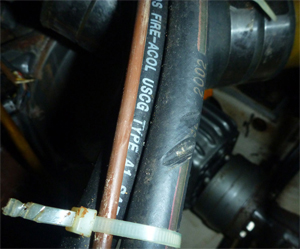 |
|
Fuel hose damage from chafing makes this another candidate for replacement, as a hose failure could produce an engine room mess. |
Taking a clean line
Fuel lines are equally important to any fuel system and should also be inspected regularly. All fittings, along with the fuel lines themselves, should be checked along their full run from the tank to the engine. Look for signs of wear and chafing, especially near moving or vibrating parts. Rubber hoses in particular need to be checked for wear, although metal piping can also fail due to corrosion. If your rubber fuel lines are more than 10 years old, you may want to consider replacing these, as rubber fuel hoses can sometimes fail internally and cause poor fuel flow or complete blockage. When replacing fuel lines, make sure to only use marine-grade hose that is U.S. Coast Guard-approved for fuel use (this will be labeled on the hose).
While looking at the fuel lines, be sure to check all the fittings and connections as well. Hoses should only be connected to other fittings with a hose barb or swaged fitting. Hoses should never be slipped over smooth tubing or pipe fittings with or without threads, as this can lead to leakage. Hose clamps should be properly sized and in good condition. Clamps that are too large can cause the hose to become egg shaped and result in leaks. Flare-type fittings should be checked for cracks in the flares and all fittings checked for leaks.
Primary filters fight back
It is inevitable that some water and dirt will get into even the best-maintained fuel systems. Good primary, along with secondary, fuel filters will keep the engine running smoothly. Many fuel filters can be equipped with water alarms and vacuum gauges. I consider these a requirement for long-distance offshore passages. Regularly check for water and sediments in the filter bowls, and pay extra attention anytime the boat has been in a heavy sea that can stir up the tanks.
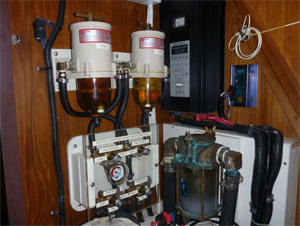 |
|
A nice filter setup with dual filters, a gauge, extensive labeling and easy access for both operation and maintenance. |
When talking about fuel filters, it is important not to overlook the secondary fuel filters, which are typically mounted on the engine just ahead of the injector pump. Secondary filters are there to not only catch any contaminants that slip by the primary filters, but also to do a final filtering to remove smaller particles that the primaries will not. These filters are usually not changed out as often as the primaries, but they still need to be replaced on a regular basis. This is more important if the primary filters were found to have heavy water or other contaminants.
A clean and well-maintained fuel system will keep all the engines running smoothly, but it does take a bit of due diligence and time from the captain. It is always better to catch a problem at dock before it becomes a problem at sea, so a few simple checks — along with careful regard to what is put into the tanks — will help keep the motors happy.
Contributing editor Wayne Canning is a marine surveyor and writer based in Florida, and the author of Fiberglass Boat Restoration. He sails an Irwin 40, Vayu, that he salvaged and restored following Hurricane Charlie.

